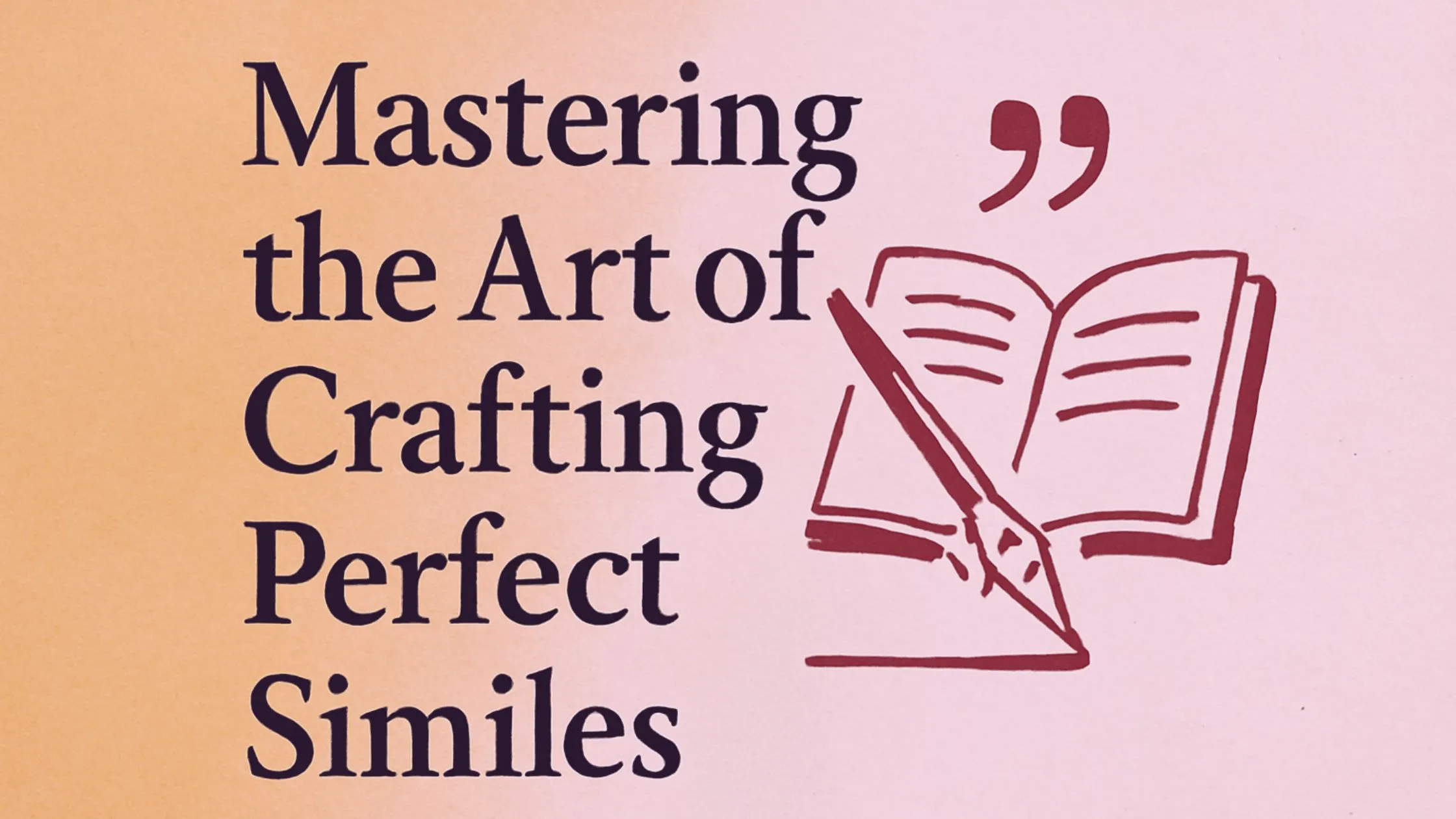Introduction
Similes are powerful literary tools that help writers convey vivid images and emotions in their writing. A simile is a figure of speech that makes a comparison between two different things using “like” or “as.” By adding these comparisons, writers can enhance creativity and make their content more relatable after this guide of Crafting Perfect Similes.
The importance of similes in writing lies in their ability to create clear, memorable imagery. They allow readers to visualize concepts and feelings more deeply, making the story or message more engaging. Through similes, writers can clarify complex ideas by linking them to everyday experiences.
This guide aims to help writers master the art of crafting effective similes. By understanding how to use similes skillfully, writers can bring their content to life, making it both engaging and easy to understand. Whether you’re a beginner or experienced writer, this guide will provide valuable insights into using similes to elevate your writing.
What is a Simile? Understanding the Basics
A simile is a figure of speech that makes a direct comparison between two different things, usually using the words “like” or “as.” It helps writers create vivid images by linking one thing to another that readers can easily understand. For example, saying “Her smile was as bright as the sun” immediately paints a clear picture in the reader’s mind.
While similes compare two things, it’s important to note that they are different from metaphors. A metaphor also compares two things, but it does so without using “like” or “as.” For instance, saying “Time is a thief” is a metaphor, not a simile.
A simple example of a simile would be: “His voice was as soft as a whisper.” This comparison helps the reader hear the softness of his voice more clearly, enhancing the storytelling.
Why Similes Are Crucial for Writers
Similes play a crucial role in writing by adding depth and vivid imagery. They allow writers to compare two unrelated things in a way that makes descriptions clearer and more engaging. By using similes, writers can evoke emotions and create strong mental images, enhancing the overall impact of their work.
In various genres such as fiction, poetry, and essays, similes help bring abstract concepts to life. For instance, in fiction, similes help describe characters and settings more dynamically, while in poetry, they add rhythm and beauty. In essays, similes can simplify complex ideas, making them easier to understand.
Similes make writing more relatable by connecting the unknown to the familiar. When readers encounter a simile, they can immediately visualize and emotionally connect to the comparison, making the content more engaging and memorable. This ability to enhance clarity and engagement is what makes similes so vital for writers.
Enhancing Storytelling with Similes
Similes have the power to transform a simple narrative into a captivating one by adding vivid descriptions and emotional depth. By comparing one thing to another, similes help readers connect with the story on a deeper level, making the experience more immersive.
- Creating Engaging Visuals: Similes provide readers with concrete imagery, making abstract ideas easier to understand. For example, “Her laughter was like the sound of a thousand bells” instantly creates a lively, joyful image.
- Building Emotional Connections: Similes also evoke emotions. In literature, similes like “The forest was as dark as a forgotten grave” set a foreboding tone that enhances the atmosphere.
- Examples from Film: In movies, similes help deepen character understanding. For instance, in The Godfather, the simile “His voice was like a deep, rolling thunder” reflects the power and authority of the character.
Using similes in storytelling makes narratives more dynamic and emotionally engaging, drawing the reader or viewer into the experience.

Mastering the Art of Crafting Perfect Similes
Crafting perfect similes requires a blend of creativity and technique. Here’s a step-by-step guide to help writers create impactful similes that enhance their writing.
1. Observe and Imagine: Using Your Senses and Imagination
Start by engaging your senses and imagination. Look around, feel, and think about how things relate to each other. This can help spark unique comparisons. For instance, “The sky was as purple as lavender” creates an immediate visual.
2. Choose the Right Comparison: Finding Something That Enhances the Description
Select comparisons that truly enhance the description. Avoid overly familiar or irrelevant comparisons. The goal is to make the reader connect with the subject in a new way.
3. Avoid Clichés: Using Fresh, Original Comparisons
Overused similes can weaken your writing. Try to create fresh and original comparisons instead of relying on common phrases like “as busy as a bee.”
4. Balance and Clarity: Ensuring the Simile Adds Clarity Without Overcomplicating the Sentence
Ensure your simile adds clarity and doesn’t confuse the reader. Keep it simple, direct, and impactful without making the sentence too complex.
By following these steps, writers can master the art of crafting similes that elevate their storytelling.
Common Mistakes Writers Make with Similes
Writers often make a few common mistakes when crafting similes, which can weaken the impact of their writing.
1. Overused or Weak Comparisons
One of the biggest mistakes is relying on clichéd or overused comparisons like “as busy as a bee” or “as cold as ice.” These comparisons lack originality and fail to add new meaning or imagery to the writing. To avoid this, writers should strive for fresh, unique comparisons that spark creativity and evoke strong images.
2. Being Overly Complex with Comparisons
Another common mistake is making comparisons too complex or convoluted, which can confuse readers. Instead of enhancing clarity, overly complex similes can disrupt the flow of the story. Writers should aim for simple, clear comparisons that enhance the reader’s understanding and keep the narrative flowing smoothly.
By avoiding these mistakes, writers can ensure their similes are effective, clear, and engaging.
Practical Tips for Writing Effective Similes
Writing effective similes involves a balance of creativity and clarity. Here are some practical tips to help writers craft similes that truly enhance their writing.
1. Use Concrete and Sensory Language
To make similes impactful, writers should focus on concrete and sensory language. Describing something using sight, sound, touch, taste, or smell helps the reader visualize and feel what’s being described. For example, “Her smile was as sweet as honey” creates a tangible, sensory image that the reader can easily connect with.
2. Keep Comparisons Simple and Relatable
Effective similes are often simple and relatable. Complex or abstract comparisons can confuse readers. Keeping comparisons familiar and straightforward helps ensure clarity, like “The water was as clear as glass.”
3. Don’t Force a Simile Where One Isn’t Needed
Sometimes less is more. If a simile doesn’t add value or enhance the description, it’s best to leave it out. Forcing a simile can disrupt the flow of writing, so always make sure it serves a purpose in the sentence.
By following these tips, writers can create clear, engaging similes that enhance their storytelling.
Simile vs. Metaphor: Which One to Use?
Understanding the difference between a simile and a metaphor is crucial for writers aiming to create vivid, engaging descriptions. Both similes and metaphors make comparisons, but they do so in different ways.
- Simile: A simile uses “like” or “as” to compare two things. It’s ideal for creating clear, relatable imagery. For example, “Her hair was as golden as the sun” helps readers visualize the hair color by connecting it to something familiar.
- Metaphor: A metaphor makes a direct comparison without using “like” or “as.” It’s often more subtle and powerful. For instance, “Her hair was golden sunlight” creates a stronger, more immediate image by equating the hair to sunlight.
Use a simile when you want a direct, easy-to-understand comparison, and a metaphor when you aim for a more abstract or deeper connection. Each has its place in writing, and knowing when to use which one can significantly enhance storytelling.
Examples of Powerful Similes in Writing
Powerful similes can elevate writing by adding vivid imagery and emotional depth. Here are a few examples from literature and popular writing that demonstrate the effectiveness of similes:
- “Her smile was as bright as the sun.” This simile, commonly used in literature, emphasizes the warmth and radiance of a character’s smile, creating an immediate visual connection for the reader.
- “The night sky was as dark as ink.” This comparison helps readers easily visualize the depth of darkness, evoking a sense of mystery and intrigue.
- “His words cut through the air like a knife.” This simile conveys the sharpness and power of his speech, highlighting its impact on those who hear it.
These similes work because they use simple, relatable comparisons that enhance the reader’s understanding and emotional engagement, making the writing more dynamic and memorable.
Breaking Down the Best Similes
Let’s take a look at two well-known similes and break down why they are so effective in writing.
- “As brave as a lion.” This simile works because it draws a direct comparison to an animal known for its courage and strength. It immediately conveys the quality of bravery in a simple and relatable way, making it easy for readers to understand and visualize.
- “Her voice was as smooth as silk.” This comparison is effective because it uses a familiar texture to convey the smoothness of her voice. The simile appeals to the reader’s senses, making the description more tangible and vivid.
These similes are effective because they use familiar, easily understood comparisons that instantly paint a clear picture, adding depth and emotional resonance to the writing.
How to Avoid Overusing Similes in Your Writing
Similes are a powerful tool in writing, but moderation and balance are essential for their effectiveness. Overusing similes can overwhelm the reader and distract from the main message, diluting the impact of the writing.
The Importance of Moderation
While similes can bring life to descriptions, using too many in a single piece can make the writing feel forced. Instead, writers should focus on using similes sparingly and only when they truly enhance the narrative or add clarity.
When Similes Are Most Effective
Similes are most effective when they highlight key moments, emotions, or settings, helping readers connect with the text. However, when used excessively, they can clutter the prose and detract from the story’s flow. Striking the right balance ensures similes serve their purpose without becoming distractions.
By being mindful of when and how to use similes, writers can maintain clarity and keep their writing engaging.
Conclusion: Perfecting Your Simile Craft
Mastering the art of crafting perfect similes is an essential skill for any writer. By understanding when and how to use similes, writers can bring their descriptions to life, adding depth, clarity, and emotional impact to their work. Whether it’s through observing and imagining, choosing the right comparisons, or avoiding clichés, each step plays a crucial role in creating similes that resonate with readers.
Similes are most effective when used thoughtfully and sparingly. Overuse can detract from their power, so maintaining balance is key. By practicing and refining this technique, writers can elevate their storytelling, ensuring that each simile serves a purpose and enriches the narrative.
As writers continue to experiment with similes, they will perfect their craft, creating vivid, memorable writing that leaves a lasting impression on readers.

